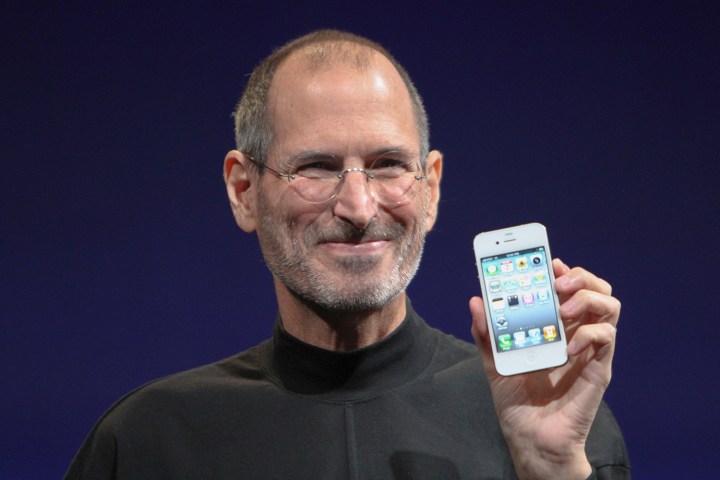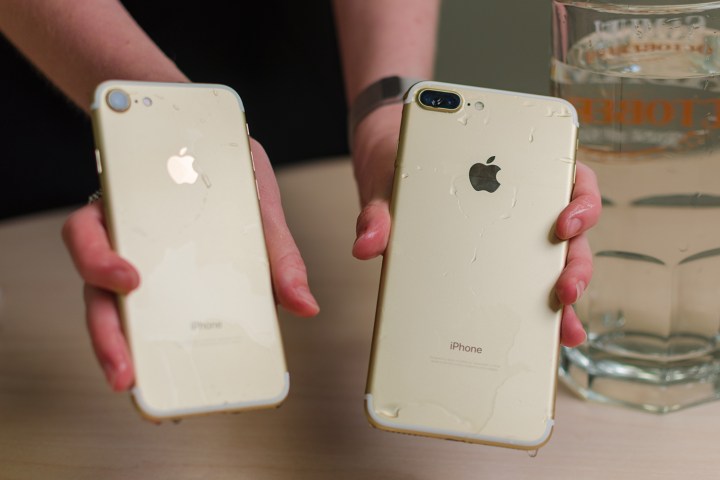
The first iPhone lacked 3G connectivity and didn’t have an App Store. It had a rear camera, but didn’t allow sending images via text messages. Multitasking wasn’t a thing, and that’s to say nothing of how infamously buggy, unreliable, and incomplete the product was when Jobs first demoed it in front of a MacWorld audience in 2007. The entire mobile industry was a different place, too. Cingular Wireless was still around, and the leading smartphones of the day came from the likes of Nokia, BlackBerry, Palm, and Motorola, sporting QWERTY keyboards nearly as large as their screens.
To commemorate the 10th anniversary, we’ve compiled a list of milestones that have accompanied every iPhone release – all the way from that very first iteration all those years ago, to last year’s
iPhone (2007)
There are so many features the original iPhone introduced, but you can pare down the major advancements to two: Multi-touch, and iOS. While the iPhone wasn’t the first phone to launch with a capacitive touch screen – LG’s Prada beat it to the market by a handful of weeks – it handled scrolling and gestures far better than anything that had come before. As a result, navigation was not only quicker, but much more intuitive.
Meanwhile, iOS served as the perfect partner for the breakthrough interface, giving rise to a modern, high-resolution operating system that was built to handle everything from music playback to widescreen web browsing entirely through touch. While iOS continues to evolve year after year, the look, feel, and behavior established here have long endured the test of time.
iPhone snapshot on Internet Archive
iPhone 3G (2008)

You could make the case that the iPhone 3G was the most important iteration ever released in the product line, and that’s down to another two additions: 3G data and the App Store. Yes, web browsing and sending emails were technically possible over GPRS and EDGE on the original iPhone, but painfully slow download speeds meant you’d want to avoid it in favor of Wi-Fi at all costs. The inclusion of 3G made it possible to have a desktop-like browsing experience on the go – a major breakthrough back in 2008 that would become even more critical thanks to the release of the App Store.
While the App Store made its way to the original iPhone as part of the iOS 2 update, it shipped with the iPhone 3G out of the box. A smartphone is nothing without its apps, and the ability to download third-party software transformed the iPhone from a cool gadget with little practical appeal to a must-have multi-tool limited only by developers’ imaginations.
iPhone 3G snapshot on Internet Archive
iPhone 3GS (2009)

The third-generation iPhone established a pattern of release that is still in practice to this day – the “S” model. Apple’s Phil Schiller said the letter stood for “Speed” when he announced the iPhone 3GS at WWDC, and truthfully that was the main area of improvement. Many of the new features offered here, like cut, copy, and paste and MMS support, would make their way to older iPhones through a software update. In terms of hardware, the primary upgrade was an all-new 3-megapixel camera with autofocus and video recording. This was the first time Apple really doubled down on the camera experience on its devices, setting a tone for future products. It would contribute to the iPhone’s reputation as the
iPhone 3GS snapshot on Internet Archive
iPhone 4 (2010)
After the 3GS polished some of the iPhone’s rough edges, the fourth generation was a major leap forward. The iPhone 4 brought numerous enhancements, from a front-facing camera to a significantly more powerful processor, double the memory, and, last but certainly not least, Verizon support. But the real stars of the show were the all-new design and Retina display. The iPhone 4’s combination of glass and metal would define the style of the product line for the next five years, until the iPhone 6 brought a more curvaceous form. Meanwhile, the increased pixel density of the 3.5-inch Retina panel provided a level of clarity never before seen on a
However, you can’t talk about the iPhone 4 without mentioning its one critical flaw: that pesky antenna. The stainless steel frame that served as the iPhone 4’s antenna was divided into segments for different transmissions, and separated by breaks along the bottom left, right, and top. Unfortunately, these gaps could be easily covered up depending on how you held the phone, crippling signal strength. The issue could be mitigated through the use of a case or Apple’s first party bumpers, which were provided for free for a short time to those affected.
iPhone 4 snapshot on Internet Archive
iPhone 4S (2011)

While previous iPhones supported voice control, Apple invested heavily in the feature with the introduction of Siri alongside the iPhone 4S. Siri was billed as a personal assistant that could answer queries and carry out certain tasks, like sending texts, scheduling calendar events, and setting alarms. At launch it lacked the predictive functionality that makes many of today’s assistant’s so useful. Speaking of texting, iOS 5, which launched alongside the 4S, added iMessage as a replacement for SMS. It also introduced iCloud for backup and restore purposes – making the 4S the first iPhone that could be set up entirely without a computer or iTunes.
iPhone 4S snapshot on Internet Archive
iPhone 5 (2012)

Another major iPhone number brought another significant redesign – though not quite as profound as the iPhone 4’s before it. The phone retained the basic style of its predecessor but became taller, increasing screen size to 4 inches while adopting a 16:9 aspect ratio for true widescreen support. The 30-pin connector, a staple of Apple’s hardware dating back to the original iPod, was also replaced with the new, slimmer, multi-directional Lightning port.
However the most notable addition was LTE. Apple has long been criticized for being late to adopt features enjoyed by users of competing devices, and in this case the company arrived to the party roughly a year and a half after the first LTE-enabled phones began hitting the market.
iPhone 5 snapshot on Internet Archive
iPhone 5S and 5c (2013)

Rather than simply succeeding the iPhone 5 with one device, Apple unveiled two – the premium 5S, and the lower-end 5c. The 5c repackaged the internals of its predecessor in a colorful plastic exterior – the first (and last) iPhone constructed predominantly from polycarbonate since the 3GS. Meanwhile, the 5S sported the typical enhancements befitting of an “S” year, with a couple key upgrades.
First, Touch ID embedded a fingerprint scanner in the home button, a feature many iPhone users had been clamoring for. The iPhone 5S was also the first
iPhone 5S and 5C snapshot on Internet Archive
iPhone 6 and 6 Plus (2014)

The original iPhone’s 3.5-inch display may have been “really big” according to Jobs back in 2007, but by the iPhone 5’s launch it wasn’t feeling quite so big anymore. Adding a bit of real estate to the top and bottom didn’t help things much either, and in the intervening years Apple had faced increased competition from bigger and bigger phones, like Samsung’s Galaxy Note series.
That brings us to the iPhone 6, which not only bumped the screen size up to 4.7 inches, but also introduced an even larger 5.5-inch Plus variant alongside an all-new design. In pulling a page from larger
iPhone 6 and 6 Plus snapshot on Internet Archive
iPhone 6S and 6S Plus (2015)

The iPhone 6S and 6S Plus were unique because of one significant new feature: 3D Touch. The technology relied on Apple’s Taptic engine to simulate a click-like response when elements on the screen were pressed with greater force than just a tap. The ability to distinguish taps from deep presses added another layer of interaction within iOS, similar to a right click. It would be a while before developers would embrace the feature, but it still stands as one of the iPhone’s unique capabilities that hasn’t really been matched by its
iPhone SE (2016)

If you’re in the market for a small phone that meets the performance benchmarks of larger flagships, your choices are pretty narrow. For the longest time, the iPhone satisfied these users’ needs, but the move to a larger form factor with the sixth generation left them out in the cold. Meanwhile, smaller
Thankfully, Apple returned in 2016 with the iPhone SE. Sporting the same overall design as the 4-inch iPhone 5S, the SE was more notable for what it retained or carried over rather than what it added. For example, the SE incorporated the same A9 system-on-chip and 2GB of
iPhone 7 and 7 Plus (2016)

Could the most recent iPhone also have been Apple’s most controversial? That depends on where you stand on the headphone jack debate. The company’s decision to remove support for the 3.5-millimeter connector was highly criticized when the iPhone 7 and 7 Plus launched last year, and for good reason – the plug has become a staple in
Other additions to the
With 2017 being the 10th year of the iPhone, rumors are ramping up day-by-day as we approach September to find out if the new iPhone will be called the 7S or the iPhone 8, and we may also see a special edition iPhone X.
What was your favorite iPhone, and which features were you most excited for? Sound off in the comments!
Editors' Recommendations
- 3 reasons why I’ll actually use Anker’s new iPhone power bank
- There’s a big problem with the iPhone’s Photos app
- Apple accidentally revealed a big iPad Pro display upgrade
- This one thing could make iOS 18 the best iPhone update in years
- iPhone 16: news, rumored price, release date, and more


